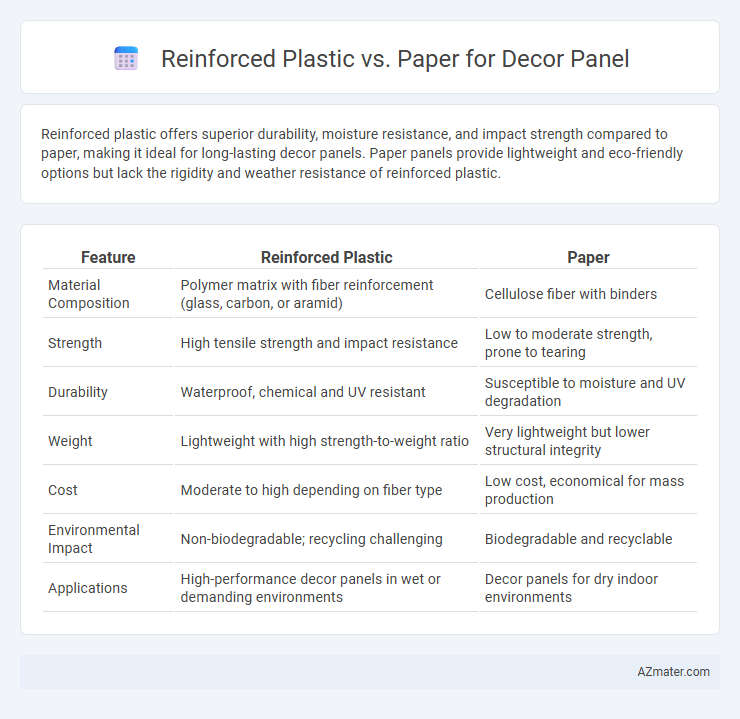Reinforced plastic offers superior durability, moisture resistance, and impact strength compared to paper, making it ideal for long-lasting decor panels. Paper panels provide lightweight and eco-friendly options but lack the rigidity and weather resistance of reinforced plastic.
Table of Comparison
| Feature | Reinforced Plastic | Paper |
|---|---|---|
| Material Composition | Polymer matrix with fiber reinforcement (glass, carbon, or aramid) | Cellulose fiber with binders |
| Strength | High tensile strength and impact resistance | Low to moderate strength, prone to tearing |
| Durability | Waterproof, chemical and UV resistant | Susceptible to moisture and UV degradation |
| Weight | Lightweight with high strength-to-weight ratio | Very lightweight but lower structural integrity |
| Cost | Moderate to high depending on fiber type | Low cost, economical for mass production |
| Environmental Impact | Non-biodegradable; recycling challenging | Biodegradable and recyclable |
| Applications | High-performance decor panels in wet or demanding environments | Decor panels for dry indoor environments |
Introduction to Decor Panel Materials
Reinforced plastic decor panels offer superior durability, water resistance, and ease of maintenance compared to traditional paper-based panels, making them ideal for high-traffic or moisture-prone areas. Paper panels, often composed of laminated decorative paper layers, provide cost-effective options with customizable designs but lack the structural strength and longevity of reinforced plastics. The choice between reinforced plastic and paper materials depends on the balance between budget, aesthetic requirements, and environmental exposure in interior applications.
Overview of Reinforced Plastic Panels
Reinforced plastic panels are engineered composites combining plastic resins with fibers such as fiberglass, offering exceptional strength, durability, and moisture resistance compared to paper-based panels. These panels provide superior impact resistance and long-term stability, making them ideal for high-traffic and humid environments in interior and exterior decor applications. Their lightweight nature and ease of fabrication also enable versatile design possibilities while maintaining structural integrity.
Overview of Paper-Based Decor Panels
Paper-based decor panels feature high-density fiberboard infused with decorative paper layers, offering cost-effective and eco-friendly alternatives to reinforced plastic. They provide good dimensional stability, smooth surface finish, and versatile design options suitable for interior wall cladding and furniture applications. Moisture resistance and durability are enhanced with specialized coatings, making paper-based panels competitive in aesthetic appeal and sustainability compared to reinforced plastic counterparts.
Durability Comparison: Reinforced Plastic vs Paper
Reinforced plastic panels offer superior durability compared to paper panels, with enhanced resistance to moisture, impact, and wear. Reinforced plastic resists warping, tearing, and fading, maintaining its structural integrity in high-traffic or humid environments. Paper panels, while lightweight and cost-effective, are prone to damage from water exposure and physical stress, limiting their lifespan and suitability for long-term decor applications.
Aesthetic Versatility and Design Options
Reinforced plastic panels offer superior aesthetic versatility with their ability to closely mimic natural materials like wood, stone, and metal while providing a wide range of colors and textures. Paper-based decor panels, though eco-friendly and lightweight, lack the durability and extensive design customization available with reinforced plastics. Enhanced design options in reinforced plastic allow for intricate patterns and finishes that maintain long-term visual appeal in diverse interior applications.
Environmental Impact and Sustainability
Reinforced plastic panels offer high durability and resistance to moisture but pose significant environmental concerns due to their non-biodegradable nature and challenges in recycling, leading to long-term waste accumulation. Paper-based decor panels are more sustainable, derived from renewable resources, biodegradable, and often recyclable, minimizing their ecological footprint. Selecting paper over reinforced plastic supports eco-friendly practices by reducing plastic pollution and promoting circular economy principles in interior design.
Cost Analysis and Affordability
Reinforced plastic panels typically incur higher upfront costs due to advanced materials and manufacturing processes, while paper-based panels offer a more affordable alternative owing to lower raw material expenses and simpler production. Maintenance and durability favor reinforced plastic, potentially reducing long-term replacement costs despite initial investment differences. Budget-conscious projects prioritize paper panels, whereas long-term value assessments often lean towards reinforced plastics for enhanced lifespan and reduced upkeep.
Maintenance and Cleaning Requirements
Reinforced plastic decor panels require minimal maintenance, offering high resistance to moisture, stains, and mold, making them ideal for environments prone to humidity or spills. Paper-based panels demand more frequent cleaning and are susceptible to water damage, staining, and wear, necessitating careful handling and protective coatings to extend durability. Choosing reinforced plastic panels enhances long-term upkeep efficiency and ensures consistent aesthetic appeal with simple cleaning using mild detergents.
Installation Methods and Practicality
Reinforced plastic panels offer quick installation with lightweight properties and require minimal tools, making them ideal for complex surfaces and wet environments due to their moisture resistance. Paper-based decor panels often need careful handling, precise adhesive application, and are less suitable for high-humidity areas, increasing installation time and maintenance concerns. Practicality favors reinforced plastic for durability and ease of cleaning, while paper panels excel in cost-effectiveness and eco-friendliness but demand more cautious installation procedures.
Best Use Cases for Each Material
Reinforced plastic panels excel in environments requiring high durability, moisture resistance, and impact strength, making them ideal for kitchens, bathrooms, and commercial spaces. Paper-based decor panels offer superior breathability, eco-friendliness, and cost-effectiveness, best suited for low-moisture indoor applications such as residential walls and decorative accents. Selecting the appropriate material depends on balancing factors like environmental exposure, aesthetic preferences, and maintenance requirements.

Infographic: Reinforced plastic vs Paper for Decor panel
 azmater.com
azmater.com